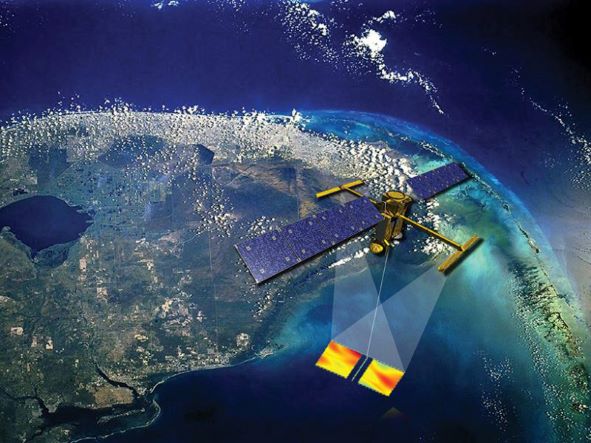By Randy Showstack

Image courtesy of NASA
Thomas Farrar, the oceanography science co-lead for the Surface Water and Ocean Topography (SWOT) mission, says that when the satellite launches in late 2022, it will provide huge advances for physical oceanography and revolutionize hydrology.
The $754.9 million spacecraft and its precise satellite altimeter will detect ocean features with 10 times better resolution than current technologies. SWOT’s satellite altimeter, which can make a global measurement of the surface topography, will be able to distinguish structures such as eddies and internal waves that occur on scales of 100 kilometers or less. This will help scientists better understand the climate system and track nutrients and pollutants. SWOT also will provide for very accurate monitoring of sea level rise.
Farrar, an associate scientist with tenure in the Physical Oceanography Department at the Woods Hole Oceanographic Institution, said SWOT “will really open our eyes to a lot of variability in the ocean that we have been blind to.”
The SWOT mission also will be the first global survey of Earth’s surface water, providing an inventory of global resources from data from lakes and rivers around the world. This will help to monitor the amount of freshwater around the globe, the terrestrial global water cycle, and the dynamics of floodplains and wetlands.
For many hydrologists, SWOT “is not yet even on their radar, so to speak,” Farrar said about the mission that is a collaboration between NASA and the French space agency Centre National d’Etudes Spatial, with contributions from the Canadian Space Agency, and United Kingdom Space Agency.
However, after SWOT launches, hydrologists will be able to get more information about the height of rivers upstream from population centers. They will also be able “to study all the rivers in the world and weave a bigger story than the kind of regional scientific stories they have been able to put together from a patchwork of river gauges,” he said.
For Farrar, he’s looking forward to new SWOT data that may confuse him at first. “New data are never quite what you expect. It will lead to a lot of creativity” in making sense of the data, he said. “ That’s the exciting part of doing science.”
